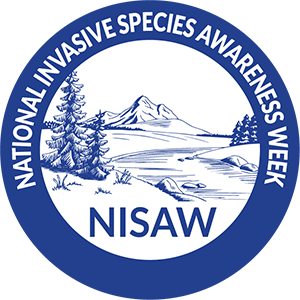What is The National Invasive Species Council?
Monday, February 24, 2020 – 12:00 PM – 1:00 PM EST
Abstract:
The National Invasive Species Council (NISC) was established to provide the vision and leadership to coordinate, sustain, and expand federal efforts to safeguard the U.S. from invasive species and their impacts. Over the past year, NISC has worked to reenvision itself institutionally and programmatically through the development of terms of reference and a new FY2020 Work Plan. These guidance documents focus on NISC’s high-level, whole-of-government perspective and direct the efforts of NISC staff toward convening and coordination to leverage existing efforts and amplify the federal impact in the fight against invasive species. In highlighting these efforts, this webinar will review NISC’s coordination mechanisms, its current thematic priorities, and efforts to engage with non-federal stakeholders. In addition to the presentation from NISC staff, senior advisers from the three NISC Co-Chair agencies will provide their perspectives on these federal coordination activities.
Speakers:
Challenges and New Technology for Managing Invasive Fish
Monday, February 24, 2020 – 2:00 PM – 3:30 PM EST
Abstract:
There are numerous vectors for introducing and spreading aquatic species, which may vary in importance and impact both spatially and temporally due to a variety of factors including species’ biology, human behavior, demography, and geopolitical issues. Here I will examine spatial and temporal change in vectors of fish introductions in the United States. Most vectors have shown a general increase in number of species introduced over time. Sanctioned (i.e., stocking by natural resource agencies) and non-sanctioned (i.e., aquarium dumping) intentional releases have historically been the major vectors of fish introduction over time. Vectors show differential geographic importance, with stocking more prevalent in western states and non-sanctioned release in the southeast. Governmental policy changes (e.g., ballast water regulations, natural resource management practices) and heightened awareness and education about impacts of introduced species may be driving a recent reduction in number of introduced species.
Bio:
Matthew Neilson is an ichthyologist with research interests in population genetics, systematics, ecology, and evolutionary biology, and is interested in understanding the patterns and processes that shape diversity in native and invasive fish faunas. He earned an MS in Biology from California State University-Long Beach, and a PhD in Biology from the University of Toledo, both centered on the population genetics and systematics of introduced gobies in the United States. He is currently a staff scientist with the US Geological Survey’s Nonindigenous Aquatic Species Database Program, tracking and analyzing fish introductions across the United States.
Vectors and patterns of freshwater fish introductions across the United States over time.
There are numerous vectors for introducing and spreading aquatic species, which may vary in importance and impact both spatially and temporally due to a variety of factors including species’ biology, human behavior, demography, and geopolitical issues. Here I will examine spatial and temporal change in vectors of fish introductions in the United States. Most vectors have shown a general increase in number of species introduced over time. Sanctioned (i.e., stocking by natural resource agencies) and non-sanctioned (i.e., aquarium dumping) intentional releases have historically been the major vectors of fish introduction over time. Vectors show differential geographic importance, with stocking more prevalent in western states and non-sanctioned release in the southeast. Governmental policy changes (e.g., ballast water regulations, natural resource management practices) and heightened awareness and education about impacts of introduced species may be driving a recent reduction in number of introduced species.
Case study: Invasive northern pike in the Columbia River Basin
Northern Pike (Esox lucius) is a highly invasive, predatory fish species that when introduced to freshwater lakes and rivers quickly takes its place at the top of the food chain. Pike eat anything that will fit into their mouth, including salmon, steelhead, bats and even ducks. Within the Columbia River Basin, Northern Pike were illegally introduced in Montana in the 1950s. Over the last several decades, downstream spread and additional illegal introductions led to the species spreading to Idaho, British Columbia, and Washington State. Northern Pike were detected in the Pend Oreille River in 2004 and have subsequently spread downstream to Lake Roosevelt. Currently, Northern Pike are less than 10 miles from Grand Coulee dam, which makes them approximately 50 miles from the anadromous portion of the Columbia River. Further downstream expansion of Northern Pike will directly impact salmon, steelhead and native resident fish and pose significant risks to tribal fisheries, commercial and sport fisheries in Washington, Oregon and British Columbia. This presentation will describe the history and current status of Northern Pike in the Columbia Basin and the environmental and economic resources that are under imminent threat by the continued spread of invasive Northern Pike in the Columbia Basin.
Case study: New technology and approaches to managing invasive fish – 10 minutes
Janine Bryan of Whooshh Innovations and Kevin Irons of Illinois Department of Natural Resources will be discussing technological advancements in the fight against invasive fish and how the results of upcoming projects could impact the future of invasive fish. Janine Bryan will be discussing the work of Whooshh Innovations and how their selective fish passage and scanning and sorting technology can be used to remove autonomously remove invasive species from waterways. Kevin Irons will be discussing a planned pilot project in Illinois to test the volitional entry of Asian Carp and how the results could change the fight against invasive Asian Carp and other species.


